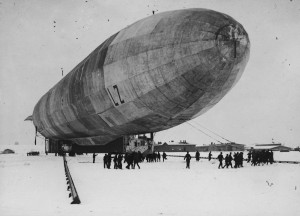Away from the Western Front, the threat of attack by German Zeppelins was a cause of great concern to the Allies, yet the anticipated mass air raids on England and France following the outbreak of hostilities did not materialise. In the spirit of ‘prevention being better than cure’ the British Royal Flying Corps and Royal Naval Air Service vied with each other to be first to take the war to the enemy. In October, Naval Sopwith Tabloid pilots bombed the Zeppelin sheds at Dusseldorf destroying the German Army’s ZIX, then a month later, three RNAS Avro 504 biplanes bombed the sheds at Friedrichshafen on Lake Constance. One of the plucky Avro pilots, Flight Lieutenant Stanley Vincent Sippe, had crossed the Rhine Valley to make an approach from the North. Flying a mere ten feet above Lake Constance to avoid detection, he hugged the shoreline before climbing when within five miles from the target. As he approached Friedrichshafen he dropped down to 700 feet, aimed one bomb at a large group of riflemen and machine gunners, then two more over the factory and one on the Zeppelin sheds blowing out a window: the fourth bomb hung-up. All the while scores of gunners were keeping up a steady barrage as the attacking Naval pilots ran a veritable gauntlet. Sippe flew out of range, then turned back to the second shed for another attempt. Still the final bomb would not budge and coming under further machine gun fire, Sippe headed back to the lake, making good his escape at low level. He returned safely as did Flight Commander JT Babington, although formation leader Edward Featherstone Briggs was not so fortunate. Wounded in the head and his Avro’s fuel tank riddled, he was compelled to land only to be set upon by infuriated locals. According to some accounts infantrymen rushed to his aid and transported him to hospital where he was well treated before transition to a prison camp.
We exist solely to keep the Aviation Legacy of World War 1 alive!


Comments are closed.